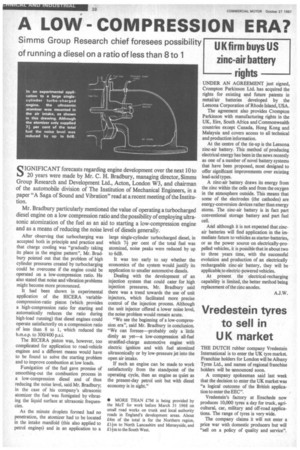A LOW-COMPRESSION ERA?
Page 40

If you've noticed an error in this article please click here to report it so we can fix it.
Simms Group Research chief foresees possibility of running a diesel on a ratio of less than 8 to 1
SIGNIFICANT forecasts regarding engine development over the next 10 to 20 years were made by Mr. C. H. Bradbury, managing director, Simms Group Research and Development Ltd., Acton, London W3, and chairman of the automobile division of The Institution of Mechanical Engineers, in a paper "A Saga of Sound and Vibration" read at a recent meeting of the Institution.
Mr. Bradbury particularly mentioned the value of operating a turbocharged diesel engine on a low compression ratio and the possibility of employing ultrasonic atomization of the fuel as an aid to starting a low-compression engine and as a means of reducing the noise level of diesels generally.
After observing that turbocharging was accepted both in principle and practice and that charge cooling was "gradually taking its place in the engine pattern", Mr. Bradbury pointed out that the problem of high cylinder pressures created by turbocharging could be overcome if the engine could be operated on a low-compression ratio. He also stated that noise and vibration problems might become more pronounced.
It had been shown in experimental application of the BICERA variablecompression-ratio piston (which provides a high-compression ratio for starting and automatically reduces the ratio during high-load running) that diesel engines could operate satisfactorily on a compression ratio of less than 8 to I, which reduced the b.m.e.p. to 300/400 p.s.i.
The BICERA piston was, however, too complicated for application to road-vehicle engines and a different means would have to be found to solve the starting problem and to improve combustion at low loads.
Fumigation of the fuel gave promise of smoothing-out the combustion process in a low-compression diesel and of thus reducing the noise level, said Mr. Bradbury; in the case of his company's ultrasonic atomizer the fuel was fumigated by vibrating the liquid surface at ultrasonic frequencies.
As the minute droplets formed had no penetration, the atomizer had to be located in the intake manifold (this also applied to petrol engines) and in an application to a large single-cylinder turbocharged diesel, in which 7+ per cent of the total fuel was atomized, noise peaks were reduced by up to 6dB.
It was too early to say whether the economics of the system would justify its application to smaller automotive diesels.
Dealing with the development of an injection system that could cater for high injection pressures, Mr. Bradbury said there was a trend towards the use of unit injectors, which facilitated more precise control of the injection process. Although the unit injector offered a lower noise level, the noise problem would remain acute.
"We see the beginning of a low-compression era", said Mr. Bradbury in conclusion. "We can foresee—probably only a little dimly as yet—a low-compression all-fuel stratified-charge automotive engine with electric ignition and with fuel atomized ultrasonically or by low-pressure jet into the open air intake.
If such an engine can be made to work satisfactorily from the standpoint of the operating cycle, then an engine as quiet as the present-day petrol unit but with diesel economy is in sight."
• MORE THAN £7M is being provided by the MoT for work before March 31 1968 on small road works on trunk and local authority roads in England's development areas. About £4m of the total is for the Northern region, £11rn to North Lancashire and Merseyside, and lim to the South West.






















































































































